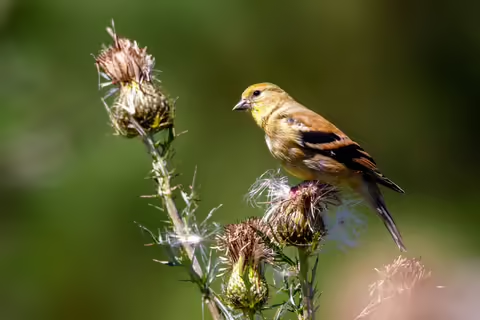URBANA, Ill. — North America has lost 3 billion birds since 1970, according to a study from the Cornell Lab of Ornithology. This is a 30% decrease.
This statistic may feel devastating and overwhelming, but Nicole Flowers-Kimmerle, a University of Illinois Extension horticulture educator, says you don’t have to feel helpless. There are some simple things that you can do to make your yard bird-friendly.
“With habitat loss and degradation being the most significant contributors to population decline, the good news is that even small green spaces can provide the four things that birds need to thrive: food, cover, water, and space,” says Flowers-Kimmerle.
Landscape plants provide the food birds need to survive and raise their young and diversity is key. Seeds, nuts, berries, and the insects plants attract are all important sources of nourishment.
Young birds eat more than you might think. Even small adult birds, the chickadee, for example, need 6,000 caterpillars to raise a clutch of young birds.
Adding plants that provide food for caterpillars ensures an important food source for growing birds. Native trees, including oak, willow, cherry, plum, and birch can support many different caterpillar species. Herbs and native perennials, such as butterfly weed, violets, and dill are also host plants for caterpillars.
Berries, nuts, and seeds are other essential food sources that provide calories to help birds prepare for overwintering or migration. Several native shrub varieties provide berries. Serviceberry, also known as Juneberry, produces berries in the early summer. Other native species, such as red twig dogwood, elderberry, viburnum, and spicebush yield berries throughout summer. Holly, chokecherry, hawthorn, and crabapple have fruit that stays on the branches, providing food all winter long.
Common sources for nuts and seeds include oak, hickory, beech, maple, and birch trees. Spruce, pine, and fir trees provide pine nuts as well as year-round shelter for birds. Herbaceous plants, such as coneflower, aster, sunflower, and goldenrod provide seeds if left in the garden until spring.
A bird-friendly yard must have cover for shelter and nesting sites. The dense structure of willow, hawthorn, holly, and conifer trees provides valuable protection. Milkweeds, native thistles, cinnamon ferns, and asters produce soft, fluffy material that many bird species use to build nests.
Adding water to your landscape will also attract birds. Small ponds with uneven edges and shallow spaces provide a place for birds to drink, splash, and bathe. A small pump will keep water moving and reduce mosquito concerns.
For a less permanent option, try a birdbath. Change the water every two to three days and clean the bath with a scrub brush once a week to keep the water clean, healthy, and mosquito-free.
A final element to consider is space. Wildlife feel more at home in layered, densely planted areas, so Flowers-Kimmerle recommends leaving part of a yard unmanicured.
Careful consideration for food, cover, water, and space in your yard will provide much-needed habitat for a variety of bird species.
“Even small changes can make a significant difference in supporting bird populations,” says Flowers-Kimmerle.
SOURCE: Nicole Flowers-Kimmerle, Horticulture Educator, University of Illinois Extension
ABOUT EXTENSION: Illinois Extension leads University of Illinois public outreach by translating research into action plans that allow Illinois families, businesses, and community leaders to solve problems, make informed decisions, and adapt to changes and opportunities.
PHOTO ACCESS: The photo in this article is available to download for media use.
